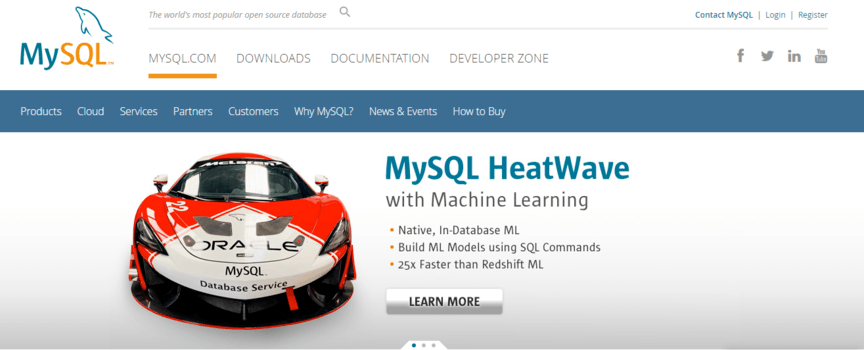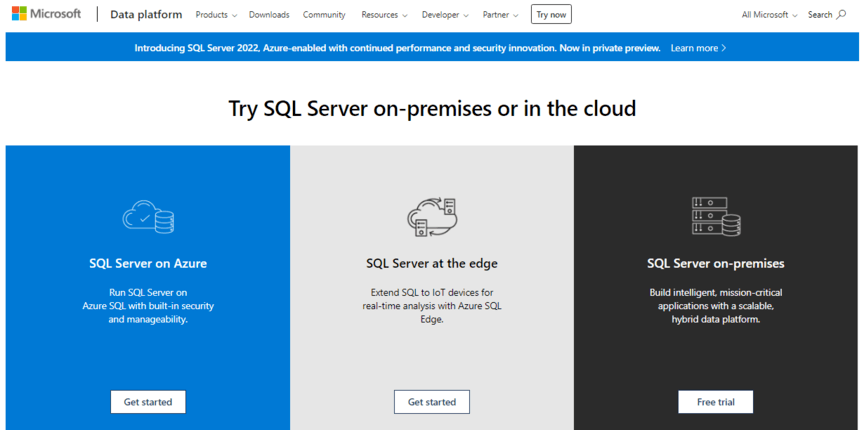-
 Published: May 12, 2022
Published: May 12, 2022
-
 8 min. read
8 min. read
-
 Abby Fields
Abby Fields Branded Content Specialist
Branded Content Specialist
- Abby is a data-driven content marketer with certifications in inbound marketing and content marketing. She’s written hundreds of articles covering digital marketing topics — a few of her specialties include first-party data, marketing and data analytics, marketing strategy optimization, and SEO. When she isn’t writing or optimizing content, Abby loves to spend time reading the latest mystery novel, having movie marathons with lots of snacks, and jamming out to Shania Twain.
Today, data is critical to implement effective marketing strategies that reach your target audience and encourage sales. But managing large amounts of data can be challenging. That’s where SQL can help.
We’ve compiled the ultimate SQL tutorial for beginners to help you master the language of SQL! Here’s a quick overview of some of the topics we’ll discuss:
So keep reading to learn more! And don’t forget to sign up for our newsletter, Revenue Weekly! Our subscribers get the latest SQL and data-driven marketing advice sent straight to their inbox from our award-winning experts for free!
What is SQL?
SQL stands for Structured Query Language. It’s a computing language you can use to communicate with databases. You’ll use SQL to perform specific tasks within your database, like retrieving or adding data.
Instead of manually sifting through large amounts of data, you can use the language of SQL to quickly and easily retrieve, edit, or add data within your database.
How to write an SQL query in 3 easy steps
The next step in our SQL tutorial is how to write an SQL query. You need to write an SQL query or command to pull, edit, or add the desired data within your database. But, how do you write an SQL query? We’ve got the answers for you!
Here’s how to write an SQL query in three easy steps:
1. Consider using a database management application
Database management tools or applications make managing your data that much easier. With database management applications, you can instantly create, update, and send queries to your database.
Check out some of our favorite database management platforms below:
1. MySQL
MySQL is one of the best data management tools with advanced features that make managing your data a breeze. Its user-friendly interface and features make it easy for anyone without a programming background to use the tool and edit data.

Whether you are an enterprise with a large amount of data or a small to medium-sized business (SMB), MySQL has the capabilities to help you organize your data.
2. Microsoft SQL Server
Microsoft’s SQL server is one of the most popular data management applications. With Microsoft SQL Server, you can create new databases from scratch or delete an existing one in just a few clicks.

In addition, you can create various custom designs and tables to organize your data. Microsoft SQL Server also enables you to use complicated SQL queries and integrate the platform with your other tools and programs.
3. Amazon Relational Database Service (RDS)
Amazon Relational Database Service, or Amazon RDS, is another popular data management application. Amazon RDS is a fully-managed, open-source cloud database platform that enables you to easily store and manage essential data and information about your business.

Not only does Amazon RDS help you pull or add data to your database with ease, but it also backs up your data in the cloud, so you never have to worry about losing any of your information.
2. Understand your database
The second step in how to write an SQL query is to understand your database. Before you can write a query to manipulate your data, you need to know where the data is located within your database.
Your database is full of various tables that house your data. For example, you might have a table that records the sources of your web traffic and another table that records how many users click on your pay-per-click (PPC) ads.
When you want to pull data from your database, you’ll need to include the location of the data in your SQL query.
For example, let’s say you want to view how many users located in the United States clicked on your PPC ads.
For this query, you would need to know the name of your table and the fields you want to pull. In this example, your table name would be “PPC ads,” and your data fields would be “users” and “location-United States.”
When you understand the hierarchy of your database, you can write accurate SQL queries that enable you to locate the information you need.
3. Write your SQL query
Now it’s time to write your SQL query. This section will highlight common SQL queries and then go over an example to help you put everything you learned together. Let’s get started!
5 most common SQL queries
Here are some of the most common SQL queries you’ll come across:
- Search: Use the “SELECT” command to choose the field you want to display. The data field is the specific piece of information you want to pull from your database.
- From: You can use the “FROM” query to pinpoint the exact table you want to pull the data from.
- Where: The “WHERE” query enables you to make your command more specific. For example, you can use “WHERE” if you only want to pull information about a particular group of users.
- Between: Use the “BETWEEN” command to pull data that falls between specific values. You can use this query when you want to pull data between specific dates or years.
- And: You can use the “AND” query to add additional information to your “WHERE” For example, you can use “AND” to pull information about users located in a specific region and who are female.
Now that you know some of the most common SQL queries let’s go over an example below so you can put them into practice!
SQL query example
Let’s use the following example: How many users in the United States clicked on your PPC ads in January 2022?
For this example, your “SELECT” statement is “users,” and your “FROM” statement is “PPC ads” because you want to pull information about the users who clicked on your PPC ads.
Next, you’ll enter your “WHERE” statement. This statement is “location = United States” since you want to see how many users in the United States clicked on your ads.
For the next step, you’ll use an “AND” and a “BETWEEN” statement to pull data from January 2021. Your query should look like this: “date BETWEEN ‘2022-01-01’ AND ‘2022-01-31.’”
Now let’s put your entire SQL query altogether. Here is what your query should look like:
“SELECT users, FROM PPC ads, WHERE location = United States, date BETWEEN ‘2022-01-01’ AND ‘2022-01-31.’”
Congratulations! You’ve just learned how to write an SQL query and completed our SQL tutorial for beginners! Now you can use SQL to manage your data quickly and efficiently to implement more data-driven marketing strategies that boost revenue for your business.
Why use SQL?
Now that you know what SQL is, you might wonder why you need to use it. Using SQL can bring many benefits to your business, including:
Managing your data with ease
SQL helps you efficiently manage large amounts of data. Data enables you to learn more about your target audience and track the success of your marketing strategies. With SQL, you can easily retrieve or add essential data to your database.
For example, you can view how many users in a particular city purchased your products or how many people signed up for your newsletter in the last 30 days.
Saving you time and resources
If you find that your to-do list is piling up, SQL can help you save time so you can get back to your other business tasks. Instead of manually searching through thousands of data points and metrics, SQL enables you to find or edit data in just a few clicks.
As a result, you can save yourself and your team valuable time and resources that you can use to complete your other tasks and drive more revenue at the same time.
Creating data-driven marketing strategies
When you use SQL, you can manage essential data about your business, website, customers, and more. You can then use these insights to inform your digital marketing strategies to drive better results.
For example, you can use an SQL query to view the sources of your web traffic. Suppose you notice that most of your web traffic comes from organic search. In that case, you can focus on optimizing your search engine optimization (SEO) strategy to boost your web traffic even more.
We foster and form long-term partnerships so that your business has long-term results.
Over 90% of WebFX clients continue partnering with us into year 2 of their campaign.
Hear from Our Happy Customers

Use SQL to implement data-driven marketing strategies with WebFX
SQL helps you organize and manage essential data and information about your customers, leads, and marketing strategies. If you’re ready to master SQL and start implementing data-driven strategies for your business, WebFX can help!
At WebFX, our team of award-winning experts has more than 28 years of experience using data to develop and implement revenue-driving strategies for clients.
In just the past few years, we’ve helped businesses like yours drive over $6 billion in revenue, and we can help your company achieve impressive results too.
Speak with one of our strategists today by calling 888-601-5359 or contact us online to learn more about how we can help you use SQL and data-driven marketing to drive sales and revenue for your business.
-
 Abby is a data-driven content marketer with certifications in inbound marketing and content marketing. She’s written hundreds of articles covering digital marketing topics — a few of her specialties include first-party data, marketing and data analytics, marketing strategy optimization, and SEO. When she isn’t writing or optimizing content, Abby loves to spend time reading the latest mystery novel, having movie marathons with lots of snacks, and jamming out to Shania Twain.
Abby is a data-driven content marketer with certifications in inbound marketing and content marketing. She’s written hundreds of articles covering digital marketing topics — a few of her specialties include first-party data, marketing and data analytics, marketing strategy optimization, and SEO. When she isn’t writing or optimizing content, Abby loves to spend time reading the latest mystery novel, having movie marathons with lots of snacks, and jamming out to Shania Twain. -

WebFX is a full-service marketing agency with 1,100+ client reviews and a 4.9-star rating on Clutch! Find out how our expert team and revenue-accelerating tech can drive results for you! Learn more
Try our free Marketing Calculator
Craft a tailored online marketing strategy! Utilize our free Internet marketing calculator for a custom plan based on your location, reach, timeframe, and budget.
Plan Your Marketing Budget

Maximize Your Marketing ROI
Claim your free eBook packed with proven strategies to boost your marketing efforts.
Get the GuideTry our free Marketing Calculator
Craft a tailored online marketing strategy! Utilize our free Internet marketing calculator for a custom plan based on your location, reach, timeframe, and budget.
Plan Your Marketing Budget





